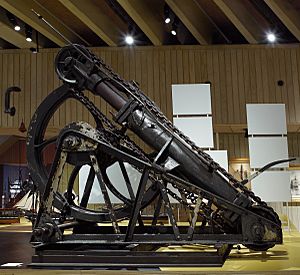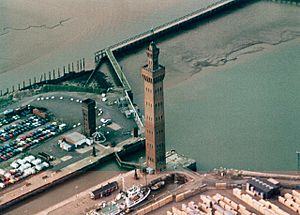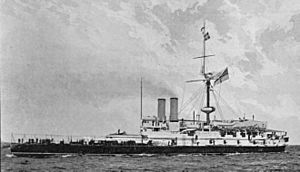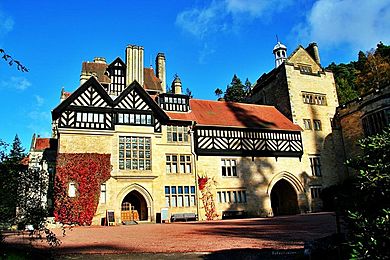William Armstrong, 1st Baron Armstrong facts for kids
Quick facts for kids
The Lord Armstrong
|
|
|---|---|
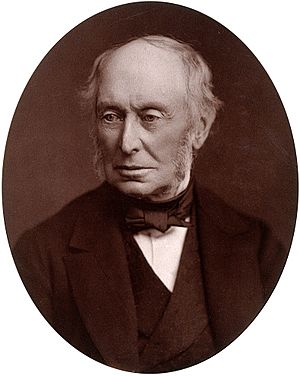 |
|
| Born | 26 November 1810 Newcastle upon Tyne, England
|
| Died | 27 December 1900 (aged 90) Rothbury, Northumberland, England
|
| Nationality | British |
| Occupation | Engineer |
| Spouse(s) | Margaret Ramshaw |
| Parent(s) | William and Anne Armstrong |
| Engineering career | |
| Discipline | Civil, Mechanical, Electrical, Structural |
| Institutions | British Association for the Advancement of Science (President), Royal Society (Fellow), Institution of Civil Engineers (President), Institution of Mechanical Engineers (President), North of England Institute of Mining and Mechanical Engineers (President), Literary and Philosophical Society of Newcastle upon Tyne (President) |
| Significant design | hydraulic crane, hydroelectric machine, accumulator, Armstrong Gun |
| Awards | Telford Medal (1850), Albert Medal (1878), Bessemer Medal (1891) |
| Signature | |
 |
|
William George Armstrong (born November 26, 1810 – died December 27, 1900) was a brilliant English engineer and business owner. He started the famous Armstrong Whitworth company in England. He was also a respected scientist, inventor, and a kind person who gave a lot to charity.
Working with architect Richard Norman Shaw, he built Cragside. This was the first house in the world to be lit by electricity made from water power! Many people see him as the inventor of modern artillery, which means powerful guns. In 1859, he was made a knight after giving his gun designs to the government. Later, in 1887, he became a Baron, known as Lord Armstrong of Cragside.
Contents
Early Life and Education
William Armstrong was born in Newcastle upon Tyne, England. His father, also named William, was a successful corn merchant. He even became the mayor of Newcastle in 1850.
William went to the Royal Grammar School, Newcastle upon Tyne. When he was 16, he moved to Bishop Auckland Grammar School. During this time, he often visited the engineering workshop of William Ramshaw. There, he met Ramshaw's daughter, Margaret, who would later become his wife.
Armstrong's father wanted him to become a lawyer. So, William studied law in London for five years. He returned to Newcastle in 1833 and became a partner in a law firm. In 1835, he married Margaret Ramshaw. They built a house in Jesmond Dene, near Newcastle. Even though he worked as a lawyer for 11 years, William spent his free time on his real passion: engineering. He even invented the "Armstrong Hydroelectric Machine" between 1840 and 1842.
A New Career Path
William Armstrong loved fishing. One day, while fishing, he saw a waterwheel that powered a marble quarry. He noticed that a lot of the water's power was being wasted. This gave him an idea!
When he got back to Newcastle, he designed a new type of engine that used water power. He then realized this engine could be perfect for a hydraulic crane. These cranes use water pressure to lift heavy things. In 1846, his work as an amateur scientist was recognized when he became a member of the Royal Society.
In 1845, Newcastle was planning to bring piped water to homes. Armstrong suggested using the extra water pressure to power a special crane at the docks. He said his hydraulic crane could unload ships faster and cheaper. The city agreed, and the crane worked so well that they installed three more!
The success of his crane made Armstrong decide to start his own business. He left his law career to build cranes and other hydraulic equipment. In 1847, his new company, W. G. Armstrong & Company, bought land by the river in Elswick, near Newcastle, to build a factory.
The company quickly grew. They received orders for hydraulic cranes from all over, including Liverpool Docks. By 1850, they made 45 cranes. Two years later, they made 75. The company employed over 300 men in 1850, and by 1863, this number jumped to 3,800! They even started building bridges, like the Inverness Bridge, finished in 1855.
The Hydraulic Accumulator
Armstrong also invented the hydraulic accumulator. This device was very important when there wasn't enough water pressure nearby to power hydraulic cranes. Sometimes, Armstrong built tall water towers to create pressure, like the Grimsby Dock Tower.
But what if the ground was too sandy to build a tall tower? Armstrong found a clever solution: the weighted accumulator. This was a heavy cylinder with a plunger inside. As the plunger slowly rose, it drew in water. Then, the heavy weight would push down on the plunger, forcing the water out at very high pressure into pipes. This invention was simple but incredibly useful for many machines.
Designing Powerful Guns
In 1854, during the Crimean War, Armstrong learned that the British Army struggled with their heavy field guns. He decided to design a lighter, more accurate gun that could shoot farther. He created a gun that loaded from the back (a breech-loading gun). It had a strong, grooved barrel made of iron wrapped around a steel lining. This gun fired a shell instead of a round ball.
In 1855, he showed a five-pounder gun to a government committee. It worked well, but they wanted a bigger one. So, Armstrong built an 18-pounder gun using the same design. This new gun was much better than any other.
Armstrong gave his gun design to the British government for free, choosing not to make money from it. Because of this, he was made a Knight Bachelor and met Queen Victoria in 1859. Armstrong then became the Engineer of Rifled Ordnance for the War Department. To avoid any conflicts of interest, he started a separate company called Elswick Ordnance Company. This company made guns only for the British government. Armstrong also helped update the old Woolwich Arsenal so it could build his new gun designs.
However, some people in the army and rival gun makers, like Joseph Whitworth, didn't like the new gun. They spread rumors that it was too hard to use, too expensive, or dangerous. Armstrong proved these claims wrong, but the constant criticism was tiring. In 1862, the government stopped ordering his new gun. This meant Elswick lost business. Eventually, the government paid compensation to Armstrong's company, which then began selling its guns to other countries.
Building Warships
In 1864, W. G. Armstrong & Company and Elswick Ordnance Company joined together to form Sir W. G. Armstrong & Company. Armstrong had left his government job, so there was no longer a conflict of interest. The company then started focusing on naval guns.
In 1867, Armstrong made a deal with Charles Mitchell, a shipbuilder. Mitchell's company would build warships, and Elswick would provide the guns. The first ship they worked on was HMS Staunch in 1868.
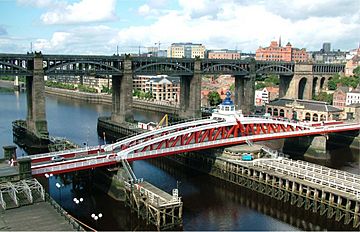
In 1876, Armstrong's company paid for a new Swing Bridge in Newcastle. The old bridge blocked large warships from reaching the Elswick factory. The new bridge could swing open, allowing warships to get their guns fitted at Elswick.
In 1882, Armstrong's company merged with Mitchell's to form Sir William Armstrong, Mitchell and Co. Ltd. By 1884, they opened a shipyard at Elswick just for building warships. They built ships for many countries, including Japan. It was said that every Japanese gun used in the Battle of Tsushima in 1905 came from Elswick. Elswick was the only factory in the world that could build a battleship and arm it completely!
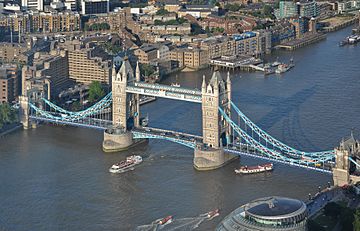
The Elswick works continued to grow. By 1870, the factory stretched for three-quarters of a mile along the river. The population of Elswick grew from 3,539 people in 1851 to 27,800 by 1871! In 1894, Elswick even built the powerful engines that operate London's famous Tower Bridge. In 1897, Armstrong's company merged with his old rival Joseph Whitworth's company, becoming Sir W. G. Armstrong, Whitworth & Co Ltd.
Armstrong brought many talented engineers to Elswick. Two important ones were Andrew Noble and George Wightwick Rendel. Their designs for gun mounts and hydraulic controls for gun turrets were used worldwide. Rendel also introduced the idea of the cruiser as a type of naval ship.
Cragside: A Home of Innovation
From 1863, Armstrong started to be less involved in the daily running of his company. He put skilled people in charge, and they continued his work. This gave him more time for his country home, Cragside.
As a child, Armstrong often visited Rothbury when he had a bad cough. He loved the area. In 1863, he bought land in a narrow valley near Rothbury. He cleared the land and built a house on a rocky ledge overlooking a stream. He also planted millions of trees and mosses to cover the rocky hillsides.
His new house was called Cragside. Over the years, Armstrong expanded the estate to 1,729 acres. He planted seven million trees and created five artificial lakes. These lakes were used to generate hydroelectricity, making Cragside the first house in the world to be lit by electricity from water power! He used special light bulbs invented by Joseph Swan.
Cragside became Armstrong's main home. In 1869, he hired the famous architect Richard Norman Shaw to make the house bigger and better. This work took 15 years. Armstrong hosted many important guests at Cragside, including the Shah of Persia, the King of Siam, and the Prince and Princess of Wales. In 1883, he generously gave Jesmond Dene, a beautiful wooded area near Newcastle, to the city.
Later Life and Legacy

William Armstrong held many important positions. He was president of the Institution of Civil Engineers and the Institution of Mechanical Engineers. In 1886, he was given the "Freedom of the City" of Newcastle, a special honor. In 1887, he was made a Baron, which allowed him to sit in the House of Lords.
His last big project, started in 1894, was buying and restoring the huge Bamburgh Castle on the Northumberland coast. This castle is still owned by the Armstrong family today.
His wife, Margaret, passed away in 1893. William Armstrong died at Cragside on December 27, 1900, at the age of 90. He was buried next to his wife. They had no children, so his great-nephew, William Watson-Armstrong, inherited his estate.
His Views on Weapons
Armstrong never seemed to regret making weapons. He once said that if he thought his work would cause wars or harm people, he would regret it. But he didn't believe it would. He felt that engineers create tools, and it's up to others to use those tools responsibly.
Supporting Clean Energy
Armstrong was a strong supporter of renewable energy. He believed that coal was being wasted and predicted that Britain would run out of coal within 200 years. Besides promoting hydroelectricity, he also believed in solar power. He once said that the amount of solar energy hitting just one acre in a tropical area could create the power of 4,000 horses working for nine hours every day!
Honors and Awards
- In 1846, he became a Fellow of the Royal Society (FRS).
- In 1850, he received the Telford Medal for his engineering work.
- In 1859, William Armstrong was made a Knight Bachelor.
- He was made a Companion of the Order of the Bath.
- In 1878, he received the Albert Medal.
- In 1886, he was given the Freedom of the City of Newcastle.
- In 1887, he became a Hereditary peer, taking the title Baron Armstrong.
- In 1891, he received the Bessemer Gold Medal for his contributions to the iron and steel industry.
- Honorary Degrees
| Location | Date | School | Degree |
|---|---|---|---|
| 1862 | University of Cambridge | Doctor of Laws (LL.D) | |
| 1870 | University of Oxford | Doctor of Civil Law (DCL) | |
| 1882 | University of Durham | Doctor of Civil Law (DCL) |
A Generous Benefactor
Armstrong was very generous. In 1883, he gave the beautiful wooded area of Jesmond Dene to the people of Newcastle upon Tyne. He also helped found the College of Physical Science in 1871, which later became Newcastle University. This college was renamed Armstrong College in 1906 in his honor.
He was president of the Literary and Philosophical Society of Newcastle upon Tyne for 40 years. Armstrong also gave £11,500 towards building Newcastle's Hancock Natural History Museum, which opened in 1882. This amount would be worth over £555,000 today!
His generosity continued even after his death. In 1901, his heir, William Watson-Armstrong, gave £100,000 (which is like millions today) to build the new Royal Victoria Infirmary in Newcastle.
Images for kids




